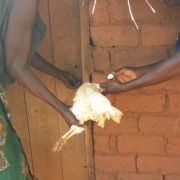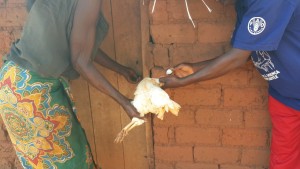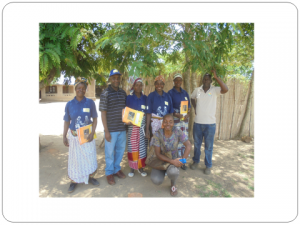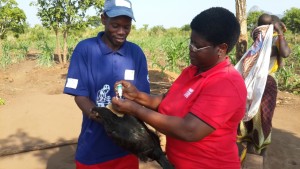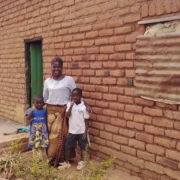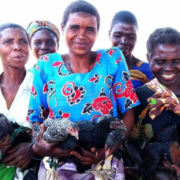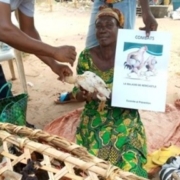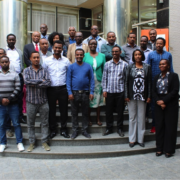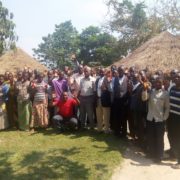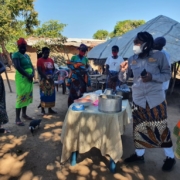Vaccination campaign delivery for the FAO livestock sub-programme in Mozambique
KYEEMA is implementing the poultry vaccination component of a European Union (EU) funded FAO project to tackle food and nutrition insecurity in Mozambique. The project is currently operating in Tete and Zambezia provinces and will expand across the country. Key activities include supporting the government to produce a quality assured I-2 vaccine for Newcastle disease, training of community vaccinators and extension workers in poultry husbandry and health as well as local nutrition education on the value of poultry products, food hygiene and healthy eating plans. A big part of what we do includes coordination and evaluation of the impact of vaccination campaigns in the community. These started in Tete in March 2015 with subsequent campaigns in both Tete and Zambezia in July and November 2015. On the advent of the next campaign in March this year, we reflect on what’s involved in a campaign and the impact to date. We also examine the main challenges and present proposed solutions going forward.
A vaccination campaign involves vaccine production and distribution, coordination meetings with the Provincial Livestock and Extension Services, extension workers and community leaders. Training of community vaccinators, awareness raising about the benefits of vaccination for the farmer and registration of chickens for vaccination are planned well ahead of the campaign date. Registration allows an estimate of the number of vaccine doses required, so that batches for each area can be ordered from the Directorate of Veterinary Services (DINAV). For a smooth running campaign, community vaccinators are equipped with extension materials such as picture-based explanatory flip charts, a uniform to identify them, locally made vaccine carrier bags, bicycles for transport between the villages and megaphones to announce their arrival. Refrigerators are also provided at local hubs for storage of the vaccine because although the vaccine is robust in hot environments, large temperature fluctuations should be avoided.
Statistics from this project are showing that there is a steady increase in chickens vaccinated, households participating (including farmers willing to pay for the service), consumption and sale of chickens, as well as average flock size in the area with repeat campaigns. See an example in the table below from Tete province.
Above: Ana Zandamela (KYEEMA staff member seated), and the extension officers with community vaccinators during monitoring of the November vaccination campaign in Macanga district, Tete province.
The project is having a positive impact. However in each area there is always room for improvement. Issues encountered in Tete include extension workers and vaccinators reporting a lack of vaccine due to underestimating the number of chickens in the registration process and the fact that not all the vaccine requested was received. For the November vaccination campaign, the vaccine also arrived in the districts only during first week of December. There was also a problem with few farmers in one district not willing to pay for the vaccination and a lack of fuel for transporting workers in monitoring activities.
In Zambezia, there was a problem with vaccine wastage; open vials of vaccine, if not used in a timely manner, have to be discarded. This can be explained by difficulties in capturing the chickens for vaccination because the children went to school and there are no chicken houses. Also, there was a delay in the delivery of bicycles, so vaccinators sometimes had to walk long distances between villages to vaccinate very few chickens. Although the project is encouraging gender balance, this is not being achieved in this district as most of the extension and livestock staff in the area are male, and some trained female vaccinators have pulled out due to their husband’s objections. Female farmers also face some constraints in attending training outside their local villages.
Above: Ms. Vitoria Namaquite, Gurue district (Zambezia province) district livestock technician helping the vaccinator during the vaccination campaign
Right:Vaccinators in Tsangano district (Zambezia province) practicing to reconstitute freeze dried vaccine.
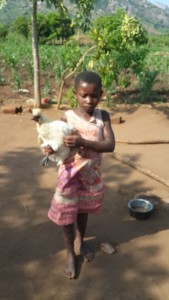
Above: Child in Zambezia province catching a chicken to be vaccinated.
Various recommendations were made by the vaccinators and extension staff at the monitoring and coordination meetings. These included ensuring that registration of chickens are made 2 months before the next campaign; boosting awareness campaigns with support from community leaders and extension staff using the existing extension materials and local radio broadcasts; and better distribution and organisation of resources for transport and Newcastle disease reporting and control activities. Gender sensitive approaches are also a continuing challenge for stakeholders in the communities and it is anticipated that with time, opportunities for encouraging gender balance will ensue.
Vaccination campaign statistics from Tete province, Mozambique in 2015:
| Target | March 2015 | July 2015 | November 2015 | |
| Vaccine doses distributed | 92, 000 | 167,500 | 176,750 | |
| Chickens vaccinated | 58, 364 | 147,200 | 158,257 | |
| Households reached | 29,000 | 5704
(19% of target) |
11,393
(39% of target) |
12,932
(44.6% of target) |
| Chickens consumed in prior 3 months
(total consumed in all the households vaccinating/average per household) |
1121/
0.19 |
3114/
0.27 |
8192/
0.63 |
|
| Chickens sold in prior 3 months
(total consumed in all the households vaccinating/average per household |
1069/
0.18 |
2818/
0.24 |
8516/
0.66
|
|
| Average flock size per household | 10.7 | 12.9 | 12.2 | |
|
Percentage of chickens vaccinated paid for |
62.39% | 90.27% |
82.5% |

